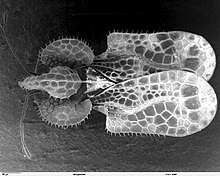Cimicomorpha
| Assassin bugs, bed bugs, and allies | |
|---|---|
 | |
| Scanning electron microscope image of a lace bug (family Tingidae) | |
| Scientific classification | |
| Domain: | Eukaryota |
| Kingdom: | Animalia |
| Phylum: | Arthropoda |
| Class: | Insecta |
| Order: | Hemiptera |
| Suborder: | Heteroptera |
| Infraorder: | Cimicomorpha Leston et al. 1954 |
| Families | |
| see text | |
The Cimicomorpha are an infraorder of insects in the order Hemiptera, the true bugs.[1] The rostrum and other morphology of all members apparently is adapted to feeding on animals as their prey or hosts. Members include bed bugs, bat bugs, assassin bugs, and pirate bugs.
The two infraorders Cimicomorpha and Pentatomorpha have very similar characteristics, possibly as a result of the evolution of plant feeding. The key similarity that unites the Cimicomorpha and Pentatomorpha is the loss of the arolia (adhesive pads) on the pretarsi of the insects. These two infraorders comprise 90% of Heteroptera species.
These insects are a part of the old, informal classification of “Geocorisae” (land bugs). Among these bugs, parental care has evolved several times. Parental care varies from brooding of the eggs by the female, to a more active form that involves protection of young against predators and the female covering the nymphs under her body.
Superfamilies and families
BioLib includes:[1]
- superfamily Cimicoidea Latreille, 1802
- Anthocoridae Fieber, 1837 – flower bugs, pirate bugs
- Cimicidae Latreille, 1802 – bedbugs
- Nabidae A. Costa, 1853 – damsel bugs
- Curaliidae Schuh, Weirauch & Henry, 2008
- Lasiochilidae
- Lyctocoridae Reuter, 1884
- Plokiophilidae China, 1953
- Polyctenidae Westwood, 1874 – Old World bat bugs
- superfamily Miroidea Hahn, 1833
- Microphysidae Dohrn, 1859
- Miridae Hahn, 1833 – plant bugs
- Ebboidae Perrichot et al., 2006
- superfamily Reduvioidea Latreille, 1807
- Reduviidae Latreille, 1807 – assassin and thread-legged bugs
- Ceresopseidae Becker-Migdisova, 1958
- Pachynomidae Stål, 1873
- Palaeotanyrhinidae Poinar, Brown & Kóbor, 2022†
- superfamily Tingoidea Laporte, 1832
- Tingidae Laporte, 1832 – lace bugs
- Hispanocaderidae Golub & Popov, 2012 †
- Ignotingidae Zhang, Golub, Popov & Shcherbakov, 2005 †
- superfamily Joppeicoidea Reuter, 1910
- Joppeicidae Reuter, 1910
- superfamily Thaumastocoroidea Kirkaldy, 1908
- Thaumastocoridae Kirkaldy, 1908 – royal palm bugs
incertae sedis and other fossil taxa
- Velocipedidae Bergroth, 1891
- Vetanthocoridae Yao et al., 2006 †
- Torirostratidae Yao, Cai, Shih & Engel 2014 †
- genus Sternocoris Popov, 1986 †
References
- ^ a b BioLib.cz: infraorder Cimicomorpha Latreille, 1802 (retrieved 28 August 2020)
External links
- True Bugs. Planetary Biodiversity Inventory.
- v
- t
- e
- Kingdom: Animalia
- Phylum: Arthropoda
- Class: Insecta
- Subclass: Pterygota
- Infraclass: Neoptera
- Superorder: Paraneoptera
Suborder Auchenorrhyncha | |||||||||||||
|---|---|---|---|---|---|---|---|---|---|---|---|---|---|
| |||||||||||||
Suborder Sternorrhyncha | |||||||||||
|---|---|---|---|---|---|---|---|---|---|---|---|
| |||||||||||
| |||||||||||||||||||||||||||||||||||||||||||||||||||||||||||||












